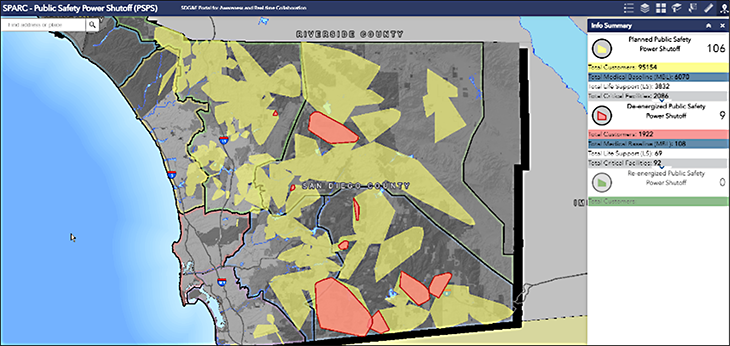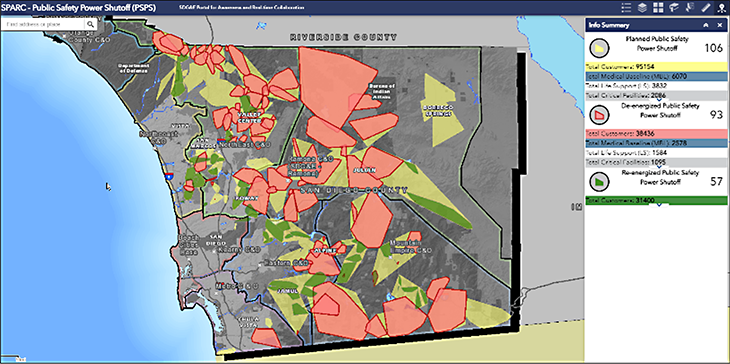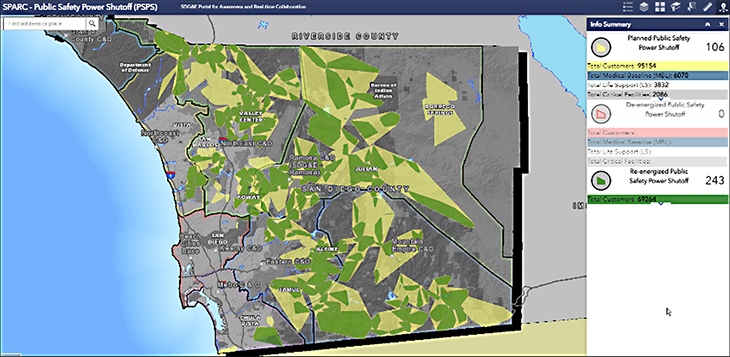In Spring of 2021, San Diego Gas & Electric (SDG&E) automated the management process for their Public Safety Power Shutoff (PSPS) events, as part of their comprehensive Wildfire Mitigation Plan. Evolving from manual to automated event management has enabled the utility to eliminate reliance on technical support for data updates, simplify the event planning process for decision-makers using preconfigured plans, spatially and statistically monitor the progressive stages of the event, and improve event and wildfire emergency communications to external stakeholders.
Content Overview
Streamlined Decision-Making Through Automation
Prior to automating the PSPS event process, SDG&E decision-makers relied on a technical team to support the entirety of the process from event planning to event closure. With the event data requiring updates every few hours from a 72-hour window prior to the event until 24 hours following, the utility realized the advantages of workflow automation to streamline the PSPS process. The updates included automating processes for identifying and previewing potential PSPS event areas, spatially and statistically displaying instantaneous data of customer de-energizations and re-energizations, and resetting the PSPS dashboard at event closure in preparation for the next event. Developed and implemented with the assistance of UDC in 2020, SDG&E’s Tabular Distribution Network (TDN) and Safe Software’s Feature Manipulation Engine (FME) now drive the complete process, requiring only minimal manual involvement from SDG&E management to approve event planning.
Enhanced Event Planning
Today, PSPS events are planned using a layer of preconfigured polygons containing pre-loaded customer information within the PSPS Viewer dashboard. Each polygon feature represents the location of electric assets and impacted customers that could potentially be de-energized by a PSPS event. This is based upon performing a downstream trace of the TDN against each of the 13,000+ existing utility sectionalizing devices (at-risk devices) to identify impacted assets and customers within SDG&E’s service territory. Prior to applying the preconfigured polygon layer, the manual addition of a new polygon to the application would take the technical team a few hours to complete.
Using meteorology reports and models from utility-owned weather stations in conjunction with algorithms, the application identifies service area polygons that could potentially be de-energized due to a high-fire or wind threat and subsequently generates a PSPS event preview. Preceding this automation, the SDG&E Fire Science and Climate Adaption Department manually identified the outage areas and created the event plans, requiring several hours of work. Applying the updated configuration technology reduces the event planning process to a few minutes, increases accuracy in area identification, allows the Meteorology and Emergency Operations Center (EOC) departments to preview and quickly edit the potential outages prior to publication, and enables the departments to make better-informed decisions regarding the outage extent.
With a sectionalized network grid and predefined PSPS event polygons, the event plan can easily be customized. Potential PSPS event polygons can be manually added, deleted, or reshaped independently of other polygons; this flexibility allows the utility to reduce the scope of the outage by having the capability to isolate specific circuit segments to high-fire threat districts (HFTD) within the polygons.


Using a preconfigured network of polygons, SDG&E decision-makers can either publish the application-recommended plan or effortlessly modify the plan, creating a streamlined and efficient planning methodology.
Tracking Events Spatially
Before developing the TDN to pre-trace at-risk-devices, SDG&E was unable to efficiently provide outage data such as impacted utility assets, customers, and communities. Using the updated spatial technology and automation, SDG&E can now view this information geographically in real-time.
Once the PSPS event is activated, an FME-powered automated process reads outages as they occur from SDG&E’s Network Management System (NMS) – spatially enabling the display of the tabular data within the ArcGIS Portal-built EOC dashboard. Refreshing every four minutes, the EOC visually monitors the specific customers and service areas as they advance through their pending, de-energized, and re-energization states – using color to visibly differentiate the stages. This automation allows SDG&E to visually view the extent of the outage, verify the event is progressing on schedule, and quickly identify any issues with re-energizations.



Tracking Events Statistically
Like the spatial data, customer-specific data also updates throughout the event stages, allowing SDG&E to quantify the impact of the event and monitor individual customer de-energizations and re-energizations in real-time. The ability to monitor specific customer outages is especially critical for ensuring that public safety facilities are restored to power on schedule.
Downstream traces from the TDN are used to create an impacted customer list, generating an Oracle table with over 12 million records that contains every customer that could be impacted by any potential PSPS scenario. This table drives the categorical customer statistics for each PSPS event polygon in the Enterprise Notification System (ENS) dashboards including the total number of customers, customers reliant on medical baseline, customers reliant on life support, and critical facilities.
Operated weekly, the TDN trace synchronizes customer information between the GIS and SAP, enabling SDG&E to have the most up-to-date customer information downstream from each transformer asset. This automated weekly load into the GIS is vital to the event planning process, allowing the utility to accurately anticipate the outage impact and effectively prepare customers for the event.

Event Communication for Safety
With the automated spatial and statistical data, SDG&E can efficiently communicate outage information to customers and wildfire emergency operations.
The PSPS plan and event data is published externally, via feature services configured in ArcGIS Online (AGOL), to CalOES and SDG&E’s public safety partners. These stakeholders can then consume this data as they see fit, either in dashboards or customized mapping applications. Public safety officers (police, fire fighters, rescue, etc.) are provided additional customer information from SDG&E, such as addresses and phone numbers, as they may need access to this information in the event of an emergency associated with the PSPS event, while customers can view estimated outage durations and restoration times through public-accessible websites.
As an added precaution, SDG&E field crews are proactively stationed near the impacted service areas in case of sparking from utility assets during de-energizations and re-energizations. With mobile access to the dashboard and outage data, the crews can effectively and safely monitor the equipment during the outage and communicate any safety hazards during or following the event.
Through the storing of PSPS event and real-time captures of the data, reports can be created following the event. With the capability to review historical PSPS events and reports, SDG&E can better improve the process, preparations, and communications for the next event and meet regulatory requests as needed from the California Public Utility Commission (CPUC).
Evolving Automation
As some public safety partners do not have access to AGOL, one remaining manual step for the technical support team includes incrementally publishing a geospatial data file (ESRI Shapefile, KMZ, GeoJSON, etc.) of the outage data to an externally-accessible SharePoint site during the event – allowing the partners to view updates and ongoing analysis of the event. For security reasons, an automated process cannot presently upload the file to SDG&E’s SharePoint cloud service without user authentication. The data team is currently working on a solution to pre-authenticate the uploads, allowing for automatic updates in real-time.
Contact UDC to learn how we can help you automate your PSPS events.
